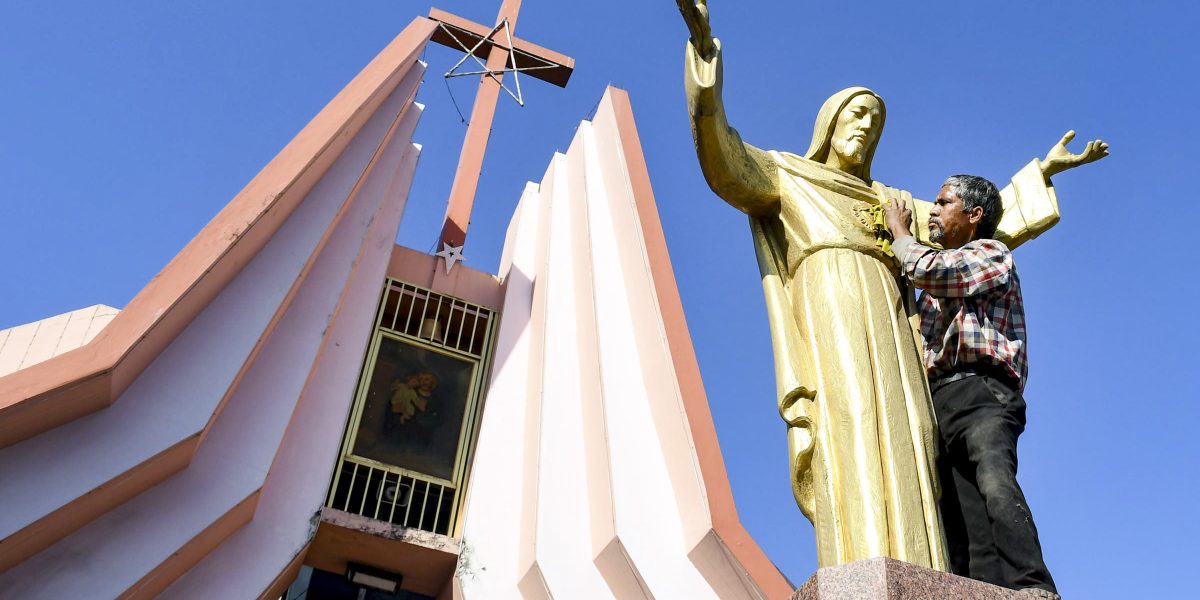
By AKANSHA DESHMUKH / Maktoob Media
It’s been two months since anti-Muslim violence broke in Madhya Prashe’s Khargone. The city is still limping back to normalcy after violence broke out on April 10 on Ram Navami. There is stillness in the town after a month of curfew and other restrictions.
Following a 25-day long curfew, some shops have been opened up now in the markets buzzing in the neighbourhoods, but ‘trust’ among the communities is ruptured through what we term the ‘Line of Control’.
The Khargone administration is well aware of the sparks still smouldering under the ashes of the violence. The admin is building concrete walls dividing Muslim localities from the Hindu ones. A heightened concrete wall, about 30ft wide and 15ft high, is being constructed to divide Khasakhwadi from the ‘zamindar’ locality, just one of the many being put up in the area.
The administration argues that this step will help in maintaining the peace and is an experiment to avert friction between the communities while the local residents remain concerned about the pragmatic difficulties the walls throw up.
Locals allude to the lack of access to civic and emergency services that have been hindered since this construction. The direct road to their homes is now blocked, and residents are forced to take a much longer, alternative route. The walls are now surrounded by fences to prevent anyone from jumping. In addition, barricades are fixed in both Sanjay Nagar and Brahmanpuri. The second wall was being built between the Vitthal temple and the Miyanman locality.
But when both sides firmly opposed the construction of this communally divisive wall rigorously, the construction was halted midway. Instead, permanent barricades were placed, which now affect around 20,000 people from the surrounding areas of Vitthal temple, Bhatwadi, Kalali, Miyaman and Tekdi.
In Bhatwadi too, the administration attempted to put up such a communally divisive wall but backed down following strong local opposition. However, they put up barricades without any thought to the civic issues they would cause: for a fortnight, the drains of Bhatwadi remained uncleaned, overflowing with sludge as the municipality trucks were unable to shuttle through to collect the piled-up garbage.
Being as good as caged in, the people here were left feeling like prisoners. Besides garbage trucks, school shuttles and other necessities also depend on this route to deliver services.
Salma Khan, a senior citizen, shared her fears: “In case of an emergency, even an ambulance will not be able to make it here.”
So far, around 20,000 people from Bohra Bakhal, including both Hindus and Muslims, were affected by the concrete blockage. Another 20,000 were affected by the barricades put up in Kalali, Miyanman and Tekdi, while 15,000 residents of Talab Chowk were bothered by the wall erected between Motipura and Sanjay Nagar.
Economic boycott
The continuous rumbling sound of Moinuddin’s flour mill located in front of the mosque had stopped. Moinuddin tells that earlier his flour mill used to grind 2 quintals of wheat daily, now it is hardly possible to get half of it. He further tells that after the violence, people from the other community have stopped coming to his shop.
Moinuddin’s flour mill, Dr Sheikh’s clinic and Javed’s medical store has been the victim of an economic boycott against the Muslim community in the town. Retired ASI’s son, employed at a local store, who belongs to the Muslim community has been asked to quit the job.
75-year-old doctor Sheikh has been seeing patients for 45 years without any fees. Locals narrate that prior to violence patients used to stand in long queues waiting for hours for their turn. The huge crowd now have been turned into a handful of people who belong to the Muslim community.
After the violence, half of Dr Sheikh’s clinic was also demolished by a bulldozer considering it to be an encroachment. A week ago, Dr Sheikh has started seeing patients again.
Javed, who runs a medical store in the neighbourhood, lost his medical store to the bulldozers.
15 days ago, Javed has started the shop again after taking permission from the municipality. Javed says that 80% of his customers belong to the Hindu community, but after the violence, no one turned up to buy from his store.
Islampura, the Muslim pocket
Retired ASI Sohrab Khan, who lives in Islampura, says that he has seen much violence but this time it seems difficult for the city to return to its old times.
Idris, a Muslim youth from Islampura, was killed in the violence.
Khan claims his son, who worked as a manager at a local auto showroom, was asked to quit the job on 6th June. Walls have now been pulled in common roads dividing both the communities.
The residents had approached the collector to voice their concerns and attempt to put a stop to the construction, but their pleas went unheard.
Deflecting any responsibility for the events taking place, Additional Collector J.S. Baghel told had taken charge in Khargone only a week ago and did not know “where and why” these walls were being built.
Though he claims to not have any concrete details on the matter, he established that the move was ill-advised. Whereas on the other hand, the collector argued that no one opposed the wall, except for protests by a few people.
Similarly, Khargone SP Dharam Veer Singh Yadav said the restrictions are temporary. He claims that the wall and barricades are a temporary mechanism put in place on a trial-and-error basis, which has proved to be effective, although not all agree to it.
This article first appeared on maktoobmedia.com





